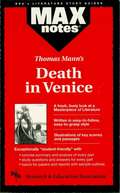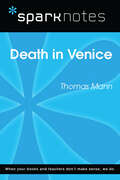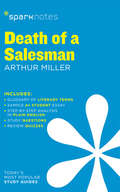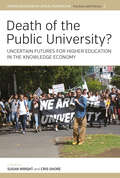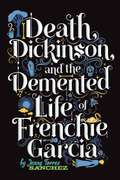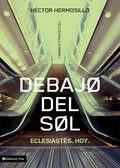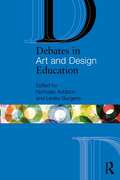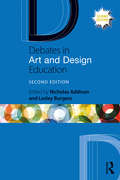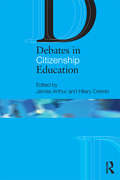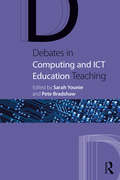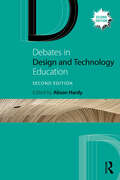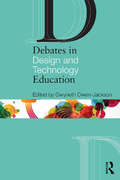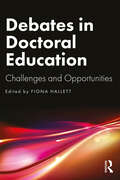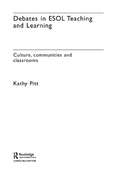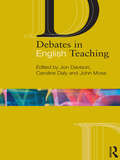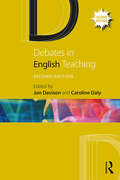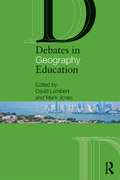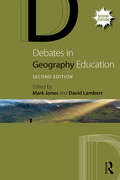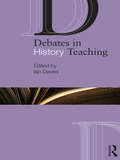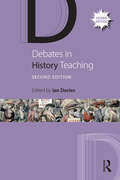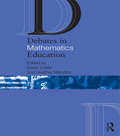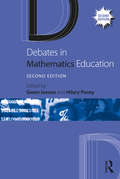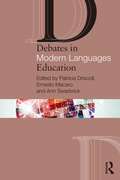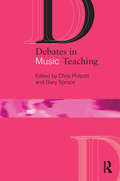- Table View
- List View
Death in Venice (MAXNotes Literature Guides)
by Boria SaxREA's MAXnotes for Thomas Mann's Death in Venice MAXnotes offer a fresh look at masterpieces of literature, presented in a lively and interesting fashion. Written by literary experts who currently teach the subject, MAXnotes will enhance your understanding and enjoyment of the work. MAXnotes are designed to stimulate independent thought about the literary work by raising various issues and thought-provoking ideas and questions. MAXnotes cover the essentials of what one should know about each work, including an overall summary, character lists, an explanation and discussion of the plot, the work's historical context, illustrations to convey the mood of the work, and a biography of the author. Each chapter is individually summarized and analyzed, and has study questions and answers.
Death in Venice (SparkNotes Literature Guide Series)
by SparkNotesDeath in Venice (SparkNotes Literature Guide) by Thomas Mann Making the reading experience fun! Created by Harvard students for students everywhere, SparkNotes is a new breed of study guide: smarter, better, faster.Geared to what today's students need to know, SparkNotes provides:chapter-by-chapter analysis explanations of key themes, motifs, and symbols a review quiz and essay topics Lively and accessible, these guides are perfect for late-night studying and writing papers.
Death of a Salesman SparkNotes Literature Guide (SparkNotes Literature Guide Series #26)
by SparkNotesDeath of a Salesman SparkNotes Literature Guide by Arthur Miller Making the reading experience fun! When a paper is due, and dreaded exams loom, here's the lit-crit help students need to succeed! SparkNotes Literature Guides make studying smarter, better, and faster. They provide chapter-by-chapter analysis; explanations of key themes, motifs, and symbols; a review quiz; and essay topics. Lively and accessible, SparkNotes is perfect for late-night studying and paper writing. Includes:An A+ Essay—an actual literary essay written about the Spark-ed book—to show students how a paper should be written.16 pages devoted to writing a literary essay including: a glossary of literary termsStep-by-step tutoring on how to write a literary essayA feature on how not to plagiarize
Death of the Public University?: Uncertain Futures for Higher Education in the Knowledge Economy (Higher Education in Critical Perspective: Practices and Policies #3)
by Susan Wright Cris ShoreUniversities have been subjected to continuous government reforms since the 1980s, to make them ‘entrepreneurial’, ‘efficient’ and aligned to the predicted needs and challenges of a global knowledge economy. Under increasing pressure to pursue ‘excellence’ and ‘innovation’, many universities are struggling to maintain their traditional mission to be inclusive, improve social mobility and equality and act as the ‘critic and conscience’ of society. Drawing on a multi-disciplinary research project, University Reform, Globalisation and Europeanisation (URGE), this collection analyses the new landscapes of public universities emerging across Europe and the Asia-Pacific, and the different ways that academics are engaging with them.
Death, Dickinson, and the Demented Life of Frenchie Garcia
by Jenny Torres SanchezTo make sense of her high school crush's suicide, Frenchie retraces her steps the last night she was with him.
Debajo del Sol: Eclesiastés
by Hector HermosilloEsta serie, a la que pronto se añadirá un nuevo volumen, Ester, también ayuda a aplicar la Palabra > a la problemática moderna. Es una exposición detallada y comentada, por capítulos, muy accesible para el lector poco familiarizado con el texto bíblico, pero con detalles que contribuyen al enriquecimiento del saber de aquellos que profundizan más en temas teológicos. Es la Palabra fresca aplicada a la vida contemporánea. El lector podrá saborear la riqueza de este libro, en el cual se concluye que la verdadera libertad se halla solo cuando se vive la vida a la manera de Dios. > (Eclesiastés 12:13).
Debates in Art and Design Education (Debates in Subject Teaching)
by Nicholas Addison Lesley BurgessDebates in Art and Design Education encourages student and practising teachers to engage with contemporary issues and developments in learning and teaching. It introduces key issues, concepts and tensions in order to help art educators develop a critical approach to their practice in response to the changing fields of education and visual culture. Accessible, comprehensive chapters are designed to stimulate thinking and understanding in relation to theory and practice, and help art educators to make informed judgements by arguing from a position based on theoretical knowledge and understanding. Contributing artists, lecturers and teachers debate a wide range of issues including: the latest policy and initiatives in secondary art education the concepts, skills and dispositions that can be developed through art education tensions inherent in developing the inclusive Art and Design classroom partnerships across the visual arts sector creativity in the Art and Design curriculum visual art and globalisation establishing the significance of ‘Design’ art practice as educational research. Debates in Art and Design Education is for all student and practising teachers interested in furthering their understanding of an exciting, ever-changing field, and supports art educators in articulating how the subject is a vital, engaging and necessary part of the twenty-first century curriculum. Each chapter points to further reading and each section suggests reflective questions to help shape art educators’ teaching. In particular, Debates in Art and Design Education encourages art educators to engage in research by providing an essential introduction to critical thinking around contemporary debates.
Debates in Art and Design Education (Debates in Subject Teaching)
by Nicholas Addison and Lesley BurgessDebates in Art and Design Education encourages student and practising teachers to engage with contemporary issues and developments in learning and teaching. This fully updated second edition introduces key issues, concepts and tensions in order to help art educators develop a critical approach to their practice in response to the changing fields of education and visual culture. Accessible, comprehensive chapters are designed to stimulate thinking and understanding in relation to theory and practice, and help art educators to make informed judgements by arguing from a position based on theoretical knowledge and understanding. Contributing artists, lecturers and teachers debate a wide range of issues including: the latest policy and initiatives in secondary art education the concepts, skills and dispositions that can be developed through art education tensions inherent in developing the inclusive Art and Design classroom citizenship education within Art and Design teaching new practices in community arts education examining ‘whiteness’ in the sector Debates in Art and Design Education is for all student and practising teachers interested in furthering their understanding of an exciting, ever-changing field, and supports art educators in articulating how the subject is a vital, engaging and necessary part of the twenty-first century curriculum.
Debates in Citizenship Education
by James Arthur Hilary CreminWhat are the key issues in Citizenship Education today? Debates in Citizenship Education encourages student and practising teachers to engage with and reflect on some of the key topics, concepts and debates that they will have to address throughout their career. It places the specialist field of Citizenship Education in a wider context and aims to enable teachers to reach their own informed judgements and argue their points of view with deeper theoretical knowledge and understanding. Taking account of recent policy and controversies, expert contributors provide a balance of experience and perspectives and cover a wide range of classic and contemporary topics including: Theoretical Perspectives on Citizenship Education; International Comparative Perspectives on Citizenship Education; Citizenship Education, Race and Community Cohesion; Climate Change and Sustainable Citizenship Education; ICT and Citizenship Education; Ethics and Citizenship Education; Assessment of Citizenship Education. Debates in Citizenship Education is for all student teachers, and practising teachers engaged in CPD or interested in furthering their understanding of teaching in the subject area. Including carefully annotated further reading and reflective questions to help shape your own research and writing, this collection provides an introduction to recent critical thinking and contemporary debates within Citizenship Education.
Debates in Computing and ICT Education (Debates in Subject Teaching)
by Pete Bradshaw Sarah YounieDebates in ICT and Computing Education explores the major issues teachers encounter in their daily professional lives. It encourages critical reflection and aims to stimulate both novice and experienced teachers to think more deeply about their practice, and link research and evidence to what they have observed in schools. Chapters tackle established and contemporary issues enabling teachers to reach informed judgements and argue their point of view with deeper theoretical knowledge and understanding. Debates include teacherless classrooms; personalised learning; creativity; digital literacy; visual literacy; e-tools; learning platforms; and opportunities for lifelong learning.
Debates in Design and Technology Education (Debates in Subject Teaching)
by Alison HardyDesign and technology is a relatively new subject compared to more traditional subjects, and during its brief existence, it has garnered widespread debate in schools. This book aims to explore some of these debates and challenges the reader with new perspectives about the subject by presenting and questioning arguments about the purpose, content and place of design and technology in the school curriculum. It will encourage the reader to critically reflect on their own beliefs and practices to reach informed judgements and perspectives that will affect how they teach and think about design and technology. Exploring the major issues that design and technology teachers encounter in their professional lives as well as introducing new topics they may never have considered before, this comprehensive second edition has been fully updated with 16 chapters focusing on emerging and enduring debates: How do we do race in design and technology? What’s so special about design and technology anyway? What is design cognition in design and technology classrooms? What is the potential of feedback in the creative processes of a design and technology classroom? Does food fit in design and technology? What is the role of making in design and technology? With its combination of expert opinion and fresh insight, Debates in Design and Technology Education is the ideal companion for any student or practising teacher engaged in initial training, continuing professional development or master’s-level study.
Debates in Design and Technology Education (Debates in Subject Teaching)
by Gwyneth Owen-JacksonDesign and Technology has long held a controversial place on the school curriculum, with some arguing that it shouldn’t be there at all. This book presents and questions considered arguments and judgements, and explores the major issues that all D&T teachers encounter in their daily professional lives. In exploring some of the key debates, it encourages critical reflection and aims to stimulate both novice and experienced teachers to think more deeply about their practice, and link research and evidence to what they have observed in schools. Written by expert design and technology education professionals, chapters tackle established and contemporary issues, enabling you to reach informed judgements and argue your point of view with deeper theoretical knowledge and understanding. Debates covered include: What is the purpose of design and technology? Is it a vocational or academic subject? What is the place of design and technology within the STEM agenda? What knowledge and skills do teachers really need? What does the design and technology gender divide mean for schools and pupils? Is it a ‘creative’ subject? What is the future for design and technology? With its combination of expert opinion and fresh insight, Debates in Design and Technology Education is the ideal companion for any student or practising teacher engaged in initial training, continuing professional development or Masters level study.
Debates in Doctoral Education: Challenges and Opportunities
by Fiona HallettDebates in Doctoral Education offers a comprehensive examination of contemporary doctoral programmes, exploring the challenges and opportunities that shape them.Split into three key sections, the book addresses fundamental debates, covering topics such as the massification of doctoral programmes, inclusivity, ethical considerations, postgraduate researcher development and the complexities of doctoral supervision. These comprehensive discussions lay the groundwork for thinking about the character of doctoral education and its broader implications. The book then shifts its focus to the challenges of supervising doctoral candidates. It examines the delicate balance that both supervisors and students must maintain throughout the doctoral journey, including considerations of preparedness, motivation, peer interactions and the academic environment. It also explores the specific challenges of professional practice doctorates and the examination of PhD theses.Designed to inspire academics to navigate the ever-evolving world of doctoral education and explore the broader implications of doctoral study, this book will provide a valuable resource for anyone involved in or interested in doctoral education, highlighting the intricacies and dynamics of this critical aspect of higher education.
Debates in ESOL Teaching and Learning: Cultures, Communities and Classrooms (New Approaches to Adult Language, Literacy and Numeracy)
by Kathy PittThis unique book provides a lively introduction to the theory and research surrounding the adult learning of English for Speakers of Other Languages. Offering a digest and discussion of current debates, the book examines a wide geographical and social spread of issues, such as: * how to understand the universal characteristics of learning an additional language* what makes a 'good' language learner* multilingualism and assumptions about monolingualism* learning the written language* the effect of recent Government immigration policy on language learning processes. As a majority of adults learning ESOL are from communities of immigrants, refugees and asylum seekers, understanding the diversity of social and personal history of learners is a critical dimension of this book. It also recognises the social pressures and tensions on the learners away from the classroom and discusses various types of classroom and language teaching methodologies. Full of practical activities and case studies, this book is essential reading for any basic skills teacher undertaking a course of professional development, from GNVQ through to post-graduate level.
Debates in English Teaching
by John Moss Jon Davison Caroline DalyWhat are the key debates in English teaching today? Debates in English Teaching explores the major issues all English teachers encounter in their daily professional lives. It engages with established and contemporary debates, promotes and supports critical reflection and aims to stimulate both novice and experienced teachers to reach informed judgements and argue their point of view with deeper theoretical knowledge and understanding. Key issues debated include: the professional identity of English teachers attitudes to correctness in grammar and standard English the importance of the media and new technologies social class and literacy the nature of the dialogic classroom the role of wider reading the politics of early literacy. With its combination of expert opinion and fresh insight, Debates in English Teaching is the ideal companion for all student and practising teachers engaged in initial training, continuing professional development and master’s level study.
Debates in English Teaching (Debates in Subject Teaching)
by Jon DavisonDebates in English Teaching explores the major issues all English teachers encounter daily in their professional lives. Written by leading experts in the field, the chapters bring together theoretical knowledge and contemporary perspectives to offer fresh insight into the most salient debates in the field of English teaching. The book supports critical reflection and will help both novice and experienced teachers to reach informed judgements and argue their point of view with deeper theoretical knowledge and understanding. This second edition has been fully updated throughout and features four new chapters. Key debates covered include: Literacy and social class English and difference Digital literacy English and mental well-being Reading for pleasure the literary canon the importance of the media and new technologies With its combination of expert opinion and fresh insight, Debates in English Teaching is an ideal companion for all student and practising teachers engaged in initial training, continuing professional development and master’s level study.
Debates in Geography Education
by David Lambert Mark JonesDebates in Geography Education encourages student and practising teachers to engage with and reflect on key issues, concepts and debates in their specialist subject teaching. It aims to enable geography teachers to reach their own informed judgements and argue their point of view with deeper theoretical knowledge and understanding. Expert editors and contributors provide a balance of experience and perspectives and offer international, historical and policy contexts, evidence informed classroom debates and a glimpse of the subject’s expanding horizons. Debates considered include: what constitutes knowledge in geography? constructing the curriculum; how do we link assessment to making progress in geography? the contribution of fieldwork and outdoor experiences; technology and media; how we use Geographical Information; how geography contributes to ‘global learning’; sustainable development and geography education. The comprehensive, rigorous coverage of these key issues, together with carefully annotated selected further reading, reflective questions and a range of specific web-based resources, will help support shape your own research and writing. Debates in Geography Education is a source of knowledge, experience and debate that will be essential reading for all students studying at Masters level, practising teachers who want to develop a better understanding of the issues that shape their practice, and Education Studies students considering in-depth subject teaching.
Debates in Geography Education (Debates in Subject Teaching)
by David Lambert Mark JonesDebates in Geography Education encourages early career teachers, experienced teachers and teacher educators to engage with and reflect on key issues, concepts and debates. It aims to enable readers to reach their own informed judgements with deeper theoretical knowledge and understanding. The second edition is fully updated in light of the latest research, policy and practice in the field, as well as key changes to the curriculum and examination specifications. Expert contributors provide a range of perspectives on international, historical and policy contexts in order to deepen our understanding of significant debates in geography education. Key debates include: geography's identity as an academic discipline; what constitutes knowledge in geography; places and regional geography; what it means to think geographically; constructing the curriculum; how we link assessment to making progress in geography; the contribution of fieldwork and outdoor experiences; technology and the use of Geographical Information; school geography and employability; understanding the gap between school and university geography; evidence-based practice and research in geography education. The comprehensive, rigorous coverage of these key issues, together with carefully annotated selected further reading, will help support and shape further research and writing. Debates in Geography Education is a key resource that is essential reading for all teachers and researches who wish to extend their grasp of the place of geography in education. Mark Jones is Senior Lecturer in Education at the University of the West of England, Bristol, UK David Lambert is Professor of Geography Education at UCL Institute of Education, London, UK
Debates in History Teaching
by Ian DaviesWhat are the key debates in history teaching today? Debates in History Teaching explores the major issues all history teachers encounter in their daily professional lives. It encourages critical reflection and aims to stimulate both novice and experienced teachers to think more deeply about their practice, and link research and evidence to what they have observed in schools. Written by a range of history professionals, chapters tackle established and contemporary issues enabling you to reach informed judgements and argue your point of view with deeper theoretical knowledge and understanding. Debates include: What is the purpose of history teaching? What do history teachers need to know? Should ‘academic history’ be taught in the classroom? What is the role of evidence in history teaching and learning? How should you make use of ICT in your lessons? Should moral learning be an aim of history education? How should history learning be assessed? With its combination of expert opinion and fresh insight, Debates in History Teaching is the ideal companion for any student or practising teacher engaged in initial training, continuing professional development and Masters level study.
Debates in History Teaching (Debates in Subject Teaching)
by Ian DaviesNow in its second edition, Debates in History Teaching remains at the cutting edge of history education. It has been fully updated to take into account the latest developments in policy, research and professional practice. With further exploration into the major issues that history teachers encounter in their daily professional lives, it provides fresh guidance for thinking and practice for teachers within the UK and beyond. Written by a range of experts in history education, chapters cover all the key issues needed for clear thinking and excellent professional action. This book will enable you to reach informed judgements and argue your point of view with deeper theoretical knowledge and understanding. Debates include: What is happening today in history education? What is the purpose of history teaching? What do history teachers need to know? What are the key trends and issues in international contexts? What is the role of evidence in history teaching and learning? How should you make use of ICT in your lessons? Should moral learning be an aim of history education? How should history learning be assessed? Debates in History Teaching remains essential reading for any student or practising teacher engaged in initial training, continuing professional development or Master's-level study.
Debates in Mathematics Education
by Dawn Leslie Heather MendickDebates in Mathematics Education explores the major issues that mathematics teachers encounter in their daily lives. It engages with established and contemporary debates, promotes and supports critical reflection and aims to stimulate both novice and experienced teachers to reach informed judgements and argue their point of view with deeper theoretical knowledge and understanding. Written by experts in the field of mathematics education, it investigates and offers fresh insight into topics of central importance, including: Gender, social inequality and mathematics Mathematics, politics and climate change The history and culture of mathematics Using popular culture in the mathematics classroom The concept of ‘ability’ and its impact on learning What we mean by ‘teaching for understanding’ Choosing and using examples in teaching The fitness of formal examinations. Designed to stimulate discussion and support you in your own research, writing and practice, Debates in Mathematics Education will be a valuable resource for any student or practising teacher engaged in initial teacher training, continuing professional development or Masters level study. It also has much to offer to those leading initial teacher education programmes, and to beginning doctoral students looking for a survey of the field of mathematics education research.
Debates in Mathematics Education (Debates in Subject Teaching)
by Gwen Ineson Hilary PoveyThis new and updated second edition of Debates in Mathematics Education explores the major issues that mathematics teachers encounter in their daily lives. By engaging with established and contemporary debates, this volume promotes and supports critical reflection and aims to stimulate both novice and experienced teachers to reach informed judgements and argue their point of view with deeper theoretical knowledge and understanding. Divided into five accessible sections, this book investigates and offers fresh insight into topics of central importance in mathematics education, with this second edition including new discussions and chapters on: Classic and contemporary issues of pedagogy, politics, philosophy and sociology of mathematics education International comparisons of achievement Digital technologies for teaching Mastery in mathematics Pop culture and mathematics Whether mathematics can be harmful Designed to stimulate discussion and support you in your own research, writing and practice through suggested questions and activities throughout, Debates in Mathematics Education will be a valuable resource for any student or practising teacher, and those engaged in initial teacher training, continuing professional development or Masters level study. This book also has much to offer to those leading mathematics departments in schools and initial teacher education programmes, and to beginning doctoral students looking for a survey of the field of mathematics education research.
Debates in Modern Languages Education (Debates in Subject Teaching)
by Patricia Driscoll Ann Swarbrick Ernesto MacaroDebates in Modern Languages Education offers a comprehensive introduction and synthesis of the major themes and research evidence in language learning and teaching today, providing an up-to-date, authoritative review of traditional and contemporary issues in language teaching. With chapters by leading experts in the field, thematic sections explore and consider: the importance of a wide range of different knowledge bases and skills for effective teaching how to become expert practitioners approaches to teaching with reference to relevant theories, complex constructs, and empirical research the innovations and ideas that shape and will shape the discipline for the next decade. Each thought-provoking chapter is supported by reference to further reading and additional material to encourage deeper exploration which will help the reader to fully engage in the debates presented. This book is a valuable resource for any student or practising teacher engaged in initial teacher education, continuing professional development and Masters level study.
Debates in Music Teaching (Debates in Subject Teaching)
by Gary Spruce Chris PhilpottDebates in Music Teaching encourages student and practising teachers to engage with contemporary issues and developments in music education. It aims to introduce a critical approach to the central concepts and practices that have influenced major interventions and initiatives in music teaching, and supports the development of new ways of looking at ideas around teaching and learning in music. Accessible and comprehensive chapters will stimulate thinking and creativity in relation to theory and practice, and will facilitate readers in reaching their own informed judgements and rationalising their position with deep theoretical knowledge and understanding. Throughout the book, international experts in the field consider key issues including: the justification for music in the school curriculum partnerships in music education and the identity of the music teacher technology and conceptions of musicianship social justice and music education the place of diverse musical genres and traditions in the music curriculum critical thinking and music education autonomy and integrity for music in cross-curricular work the politics, sociology and philosophy of music education. Debates in Music Teaching is for all student and practising teachers interested in furthering their understanding of the subject. Including carefully annotated further reading and reflective questions to help shape research and writing, this collection stimulates critical and creative thinking in relation to contemporary debates within music education.
Debates in Physical Education
by Margaret Whitehead Susan CapelDebates in Physical Education explores major issues physical education teachers encounter in their daily professional lives. It engages with established and contemporary debates, promotes and supports critical reflection and aims to stimulate both novice and experienced teachers to reach informed judgements and argue their own point of view with deeper theoretical knowledge and understanding. In addition, concerns for the short, medium and long term future of the subject are voiced, with a variety of new approaches proposed. Key issues debated include: What are the aims of physical education? What should be covered in a physical education curriculum? How should we judge success in physical education? Is physical education really for all or is it just for the gifted and talented? Can physical education really combat the rise in obesity? What is the future for physical education in the 21st Century? Debates in Physical Education makes a timely and significant contribution to addressing current contentious issues in physical education. With its combination of expert opinion and fresh insight, this book is the ideal companion for all student and practising teachers engaged in initial teacher education, continuing professional development and Masters level study.
